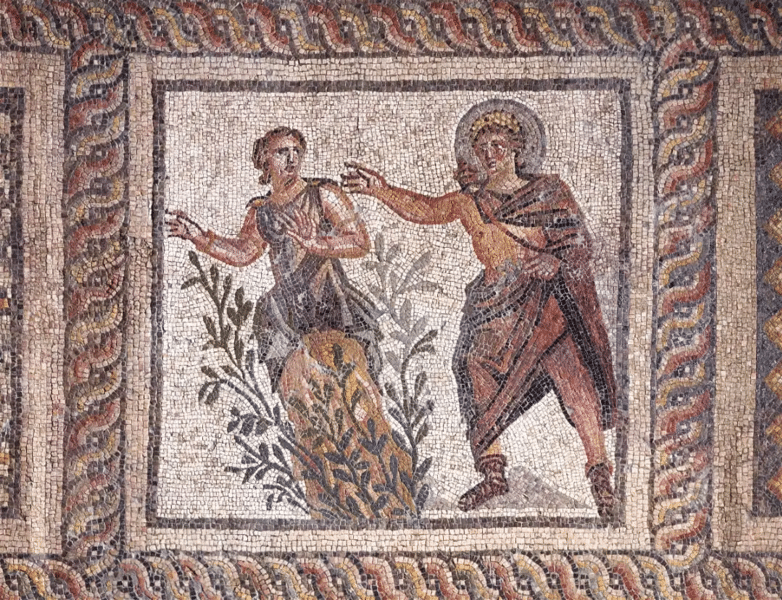In Greek mythology, we encounter a variety of nymphs, including the naiads, or freshwater nymphs. One of the most well-known naiads was Daphne, the nymph of the laurel tree. What I find particularly fascinating about Daphne’s story is how, in order to avoid Apollo’s pursuit, she chose to transform herself into a laurel tree, defying the god. Let’s learn more about this fascinating story.
Daphne Key Facts
| Keyword | Fact |
|---|---|
| Parents | Peneus (Father) and a Naiad nymph (Mother) |
| Partners | None (famously evaded Apollo) |
| Siblings | Naiads (sisters) |
| Offspring | None |
| Other names | None |
| Roman name | Daphne |
| The Nymph of | Purity, Chastity, and Transformation |
| Symbols | Laurel Tree |
Name and Etymology
In ancient Greek, Daphne translates to “laurel,” a symbol of victory and honor, which later became significantly associated with her narrative. The Roman rendition of her name remains the same, a testament to her tale’s enduring allure across cultures and eras.
The epithets and other names associated with Daphne are sparse, yet her singular name has echoed through the corridors of time, embodying a tale of innocence, pursuit, and metamorphosis. The simplicity and clarity of her name mirror the unyielding essence of her character, which stood resilient against the whims of the divine.
The etymological roots of Daphne’s name are intertwined with her fate, the laurel, becoming a symbol of poetic inspiration and victory, primarily through its association with Apollo, the god who ardently pursued her. This intertwining of name and narrative showcases the poetic justice often found in Greek mythology, where names are not mere labels but echo the essence and destiny of the bearer.
Daphne Origins
Daphne hailed from a lineage that was as serene and pure as the waters of the river Peneus, her father. Her mother, a Naiad nymph, further cements her connection to the tranquil waters. The Naiads were primarily believed to be daughters of river gods, and in Daphne’s case, this lineage played a pivotal role in shaping her destiny.
The birth of Daphne isn’t wrapped in grandiose tales, but her life was anything but ordinary. From a tender age, she exhibited a love for nature and a desire for freedom that was as vast and unyielding as the rivers she was born of. Her choice of a solitary, chaste life was a reflection of her pure essence, a trait that would later define her narrative.
The personification of Daphne as a symbol of chastity and purity is a unique narrative in Greek mythology. Unlike the often tumultuous lives of other nymphs and deities, Daphne’s tale is a serene yet powerful narrative of resistance against the desires of the divine, embodying the spirit of independence and the unyielding flow of nature’s course.
Daphne Lovers and Relationships
Daphne’s tale of love and pursuit is singular yet profoundly impactful. Her narrative with Apollo, the god of light, prophecy, and poetry, is a tale of unyielding resistance and divine desire.
Apollo’s Pursuit
Apollo, smitten by Daphne’s ethereal beauty and grace, pursued her with a fervor as bright and relentless as the sun he was associated with. However, Daphne, devoted to a life of purity and solitude, fled from his advances, her resolve as steady as the calm flow of her father’s waters.
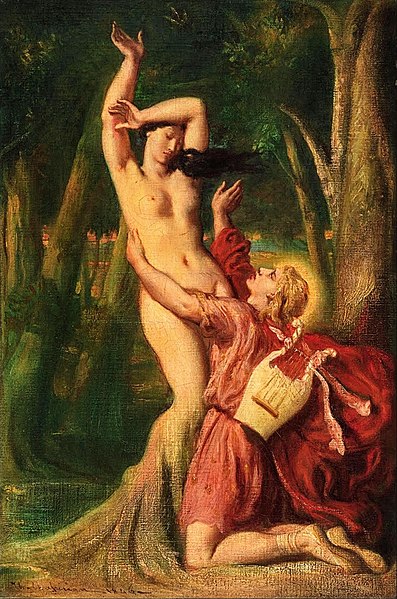
The chase, as desperate as it was passionate, ended by the tranquil banks of the river Peneus, where Daphne, exhausted and seeking escape, was transformed into a laurel tree. This metamorphosis was both an end and a beginning, a cessation of Apollo’s pursuit, and the birth of an eternal symbol of honor, victory, and poetic inspiration.
Daphne Offspring
Daphne’s choice of a chaste life led to a narrative devoid of offspring. Her tale is a rare narrative of choice and resistance against the divine whims, a narrative where her essence remained untouched by the often tumultuous liaisons between gods and mortals or gods and nymphs.
Depiction And Characteristics
Daphne’s tale is a visual and thematic feast in the realm of Greek mythology, embodying purity, resistance, and transformation.
Daphne Appearance
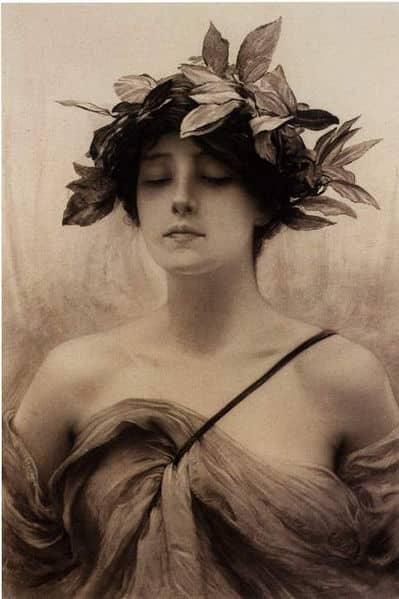
Daphne’s appearance is often described as ethereal, with a grace that was as serene and flowing as the waters she was associated with. Her beauty was not just a physical trait but an embodiment of nature’s purity and tranquility.
The laurel tree, her final form, became a symbol of her enduring beauty and purity. It stood as a testament to her choice and the divine narrative that played around her, its evergreen leaves symbolizing the eternal essence of her tale.
Daphne Personality
Daphne’s personality is a blend of gentle grace and unyielding resolve. Her choice of a chaste life, her love for nature, and her resistance against Apollo’s advances showcase a character that was as strong in resolve as it was gentle in essence.
Her story embodies a spirit of independence and a love for the natural realm. Traits that resonate both through her actions and choices, painting a picture of a nymph whose essence was as pure and unyielding as the waters she hailed from.
Being a Naiad nymph, Daphne was associated with the powers of the natural realm, particularly the waters. Her ability to transform into a laurel tree, a metamorphosis that marked the climax of her narrative, showcased a divine intervention that was as much a part of her as it was a reflection of the gods’ whims.
Daphne Symbols
The laurel tree is the most profound symbol associated with Daphne. Its evergreen leaves and enduring beauty are a reflection of Daphne’s essence, an emblem of victory, honor, and poetic inspiration.
The association of the laurel with Daphne transcends her life story. Eventually becoming a symbol of victory and honor in the ancient Greek world. The intertwining of Daphne’s tale with the laurel showcases the poetic and symbolic depth of Greek mythology, where narratives are woven with symbols that endure through time.
Daphne Roles And Responsibilities
Daphne’s role in Greek mythology is a blend of symbolism and narrative. Her tale is a reflection of the natural realm’s purity and the unyielding essence of individual choice.
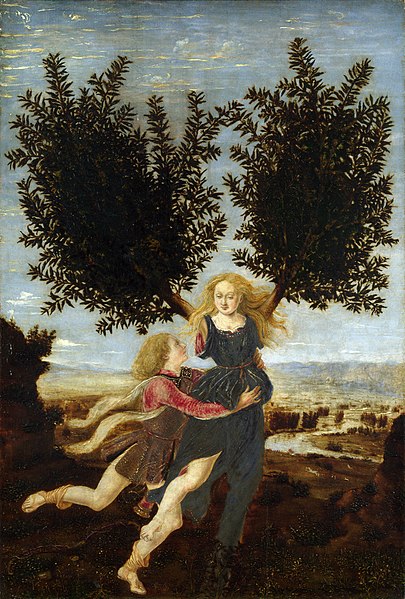
Her story is not just about pursuit and transformation, but a story exploring divine desire and mortal choice. Daphne’s choice of a chaste life and her resistance against Apollo’s advances is a powerful narrative of individual choice and the serene yet unyielding essence of nature.
Daphne Games
Play a fun wordsearch game with Daphne and other demigods:
If this one was fun, try our other equally fun games!
Myths about Daphne
Daphne’s myth is a riveting narrative of divine desire, mortal choice, and the serene yet unyielding essence of nature.
The Pursuit and Transformation
The tale of Apollo’s pursuit and Daphne’s transformation is a narrative that is as serene as it is profound. Apollo, smitten by Daphne’s beauty, pursues her with a fervor that is as bright and relentless as the sun. Daphne, on the other hand, seeks to preserve her purity and love for nature, fleeing from Apollo’s advances.
The climax of this tale unfolds by the tranquil banks of the river Peneus. There Daphne, seeking escape from Apollo’s relentless pursuit, is transformed into a laurel tree. This transformation is both an end and a beginning. Is is a cessation of Apollo’s pursuit, and the birth of an eternal symbol of honor, victory, and poetic inspiration.
Representations Of Daphne In Art
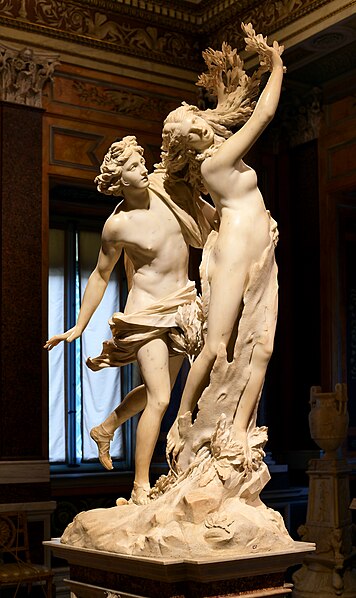
The sculpture “Apollo and Daphne” by Gian Lorenzo Bernini is a masterpiece that captures the dramatic climax of Daphne’s tale. The intricate detailing of Daphne’s transformation, with leaves sprouting from her fingers and her legs taking the form of tree trunks, is a visual feast that embodies the essence of her tale.
Furthermore, paintings and other forms of art have also explored the narrative of Daphne, each rendition offering a unique perspective on her tale, immortalizing her narrative in a myriad of hues and forms.
Mentions in Ancient Texts
Daphne’s tale has been a source of inspiration and poetic expression across various ancient texts. Her narrative of purity, resistance, and transformation resonates through the ages, offering a glimpse into the divine and mortal interplay characteristic of Greek mythology.
Ovid’s Metamorphoses
The Roman poet Ovid, narrates the tale of Daphne and Apollo in his epic book “Metamorphoses,” written around 8 AD. Ovid’s rendition of Daphne’s tale is a poetic narrative that explores the themes of love, desire, and metamorphosis. He vividly describes the chase and the dramatic transformation of Daphne into a laurel tree to escape Apollo’s advances.
In his words:
“A heavy numbness seizes her limbs, her soft breasts are girded by thin bark, her hair grows into foliage, her arms into branches; her foot, just now so swift, sticks fast in sluggish roots, her face has the top of a tree: a single splendor remains in her.” (Metamorphoses, Book 1)
Pausanias’ Description of Greece
Pausanias, a Greek traveler and geographer of the 2nd century AD, also mentions Daphne in his work “Description of Greece.” Through his writings, Pausanias provides a detailed account of ancient Greek places, rituals, and myths. In so doing, preserving a glimpse into the cultural and mythological landscape of ancient Greece.
Hyginus’ Fabulae
Gaius Julius Hyginus, a Roman author of the 1st century BC, recounts the tale of Daphne in his “Fabulae.” Hyginus, though not as poetic as Ovid, provides a straightforward account of various Greek and Roman myths. Offering a glimpse into the rich mythological tapestry of the ancient world. His rendition of Daphne’s tale echoes the themes of divine desire and mortal resistance characteristic of Daphne’s story with Apollo.
Frequently Asked Questions
Daphne was pursued by Apollo, who was smitten by her beauty. To escape his advances and preserve her chastity, she was transformed into a laurel tree. This was either by her father Peneus or by Gaia, depending on the version of the myth.
The laurel tree is associated with Daphne due to her transformation into a laurel to escape Apollo’s advances. This transformation immortalized her purity and resistance, making the laurel a symbol of victory and honor.
Daphne’s tale is a narrative of purity, resistance, and the enduring essence of nature. It explores the dynamics of divine desire and mortal choice, embodying the unyielding essence of nature and individual resolve.
No, Daphne was a Naiad nymph, associated with freshwater bodies and rivers, embodying the purity and serene beauty of nature.
Apollo was smitten by Daphne’s beauty and pursued her. However, Daphne, devoted to a life of purity, resisted his advances, leading to her transformation into a laurel tree.
Featured Image Credit: Princeton University Art Museum, Public domain, via Wikimedia Commons

